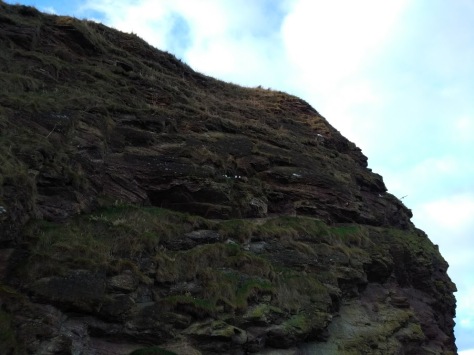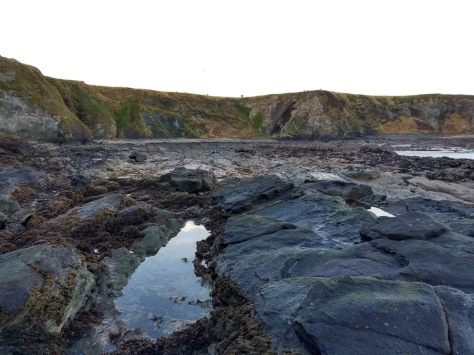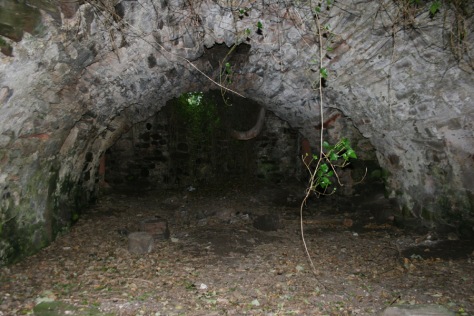
The county of East Lothian is very much a microcosm of the British Isles. We have heathy wastes, highland terrain, evergreen forests, flat plains & of course miles of myriadic coastline. One of the truest jewels in the county’s wave-lapped coast-crown is the stretch of sands & rocks between Seacliff Beach & Tantallon castle.


Before departing on this particular walk, I would at first consult the tidal situation, for it cannot be done at high tide, & as me & Daisy found its best to leave it a few hours to dry, as the rocks were quite slippy in places. To get to the launchpad, hit the A198 & head along a wee tarmac road where you see the weird stone fireplace in the wall.


At the end of the long straight road you reach a barrier, where payment of three pounds allows you to continue, through woodland & down to beachside, where a carpark makes the megasteep £3 tax a wee bit justified.



It was time to get going; there were gulls, there was a a glorious morning, there was a lady on a horse on the beach. To the right a line of rocks extended into the sea to form the cross-mounted, jagged rockiness of St Baldred’s Boat. Named after an 8th century holy man, Baldred was known as ‘the Apostle of the Lothians.’ The historian, Symeon of Durham, described, ‘the boundaries of his pastorate embraced the whole land which belongs to the monastery of Saint Balther, which is called Tyninghame – from Lammermuir to Inveresk, or, as it was called, Eskmouthe.’ His cult was certainly centred on the four churches of Auldhame, Whitekirk, Tyninghame and Prestonkirk. Of these, Auldhame once sat on the wooded headland above the beach, the ruin of whose stately castle can still be seen peeping through the trees.


On reaching the sands – lovely soft & smooth – Daisy began doing her whirly-bird revolutions around me, she is becoming quite the accomplished scamperer! As for myself, I was enjoying the seaweed & rocks & of course the Wordsworthian ribbed sand.



Hitting the rocks, we came to one of Scotland’s smallest harbours – that has been carved out of the rocks of a feature known as the Gegan. It was constructed in 1890 by Andrew Laidley, who utilsed a steam engine and compressed air to cut the stone in a wonderment of Victorian engineering.


Beyond there we found a photography class in the middle of, well, a class. It turned out to be Dunbar’s Maclean Photographics, whose theme was Beaches & Castles. Not wanting to disturb them with my ‘loving life on a winter’s Sunday morning’ vibe, I whistled Daisy to my feet & heading north along the slippery rocks. Above us the gulls were nesting in the cliffs, blasting out 4-seconds worth of staccato warnings as we got close.


At this point, at the northern end of the beach, most folk would – & should- potter back to the car. But its a bit soul-passive is that, & its better to keep going, skirting coves & cliffs & really enjoying the scramble.



The ruins of Tantallon castle were slowly growing in scope. In the 1720s, Daniel Defoe wrote a series of letters describing his wanders about Britian. In letter XI he writes of Tantallon that it was, ‘mostly buried in its own ruins; it was famous, in the Scots history, for being the seat of rebellion, in the reign of King James V. And hence came the old, and odd fancy among the soldiers, that the drums beating the Scots March, say, “Ding down tan-tallon.” That beat or march being invented by King James the Vth’s soldiers (or, perhaps, drummers) when they marched against the Earl of Angus, who held out Tantallon Castle, against the king. But this by the way: Tantallon is now no more a fortress, or able to shelter a rebel army.’

Tintallon – called DENTALOUNE on a map before 1300 – derives from the din or dun = fortress, of Taloune. In 1374, William, first Earl of Douglas wrote from, ‘our castle of temptaloun.’ He had built on one of the last great fortresses in Scotland. It was to be besieged three times; by James IV in 1491, James V in 1528, then finally & ruinously by Oliver Cromwell in 1651. Its defender, Sir James Balfour, wrote at the time (his spelling);
Fryday 21 Febrij, 1651. About 4 in the eiuning Tantallon Castle, in Louthean, was randred to Cromwell, after he had battred at the for wall 12 dayyes continually with grate cannon. Capitaine Alexander Setton defendit the same gallantly; bot afyter that the enemeyes canon had oppind a werey large breache, & filled the dray ditche with the wall, he entred it by storm. The Capitaine and thesse few men (which) wer with him, betooke themselves to (the) tower, & resolued to sell ther lives at als good a rait as they could, if that quarter should (be) denayed them; bot the enimey seinng them stand gallantly to it, preferrid them quarters, which they excepted the defenders wanted to defend, but on discovering quarter would be given, relented
After Cromwell dismantled most of the fortifications, the castle soon fell into disrepair & was abandoned to the skyline where is stands alongside its scenic sibling; the white, seagull-poo coated Bass Rock. Once the the hermitage of Saint Baldred, the ruins of an old chapel still cling to the stone, which leads us to one of East Lothian’s finest – but forgotten – lyrical poets. In 1824, James Miller published his, ‘St. Baldred Of The Bass: A Pictish Legend: The Siege Of Berwick, A Tragedy, With Other Poems And Ballads, Founded On The Local Traditions Of East Lothian and Berwickshire,’ out of which we may read;
At morning’s dawn the Bass appear’d,
Half hid in ocean’s mantle fold,
Shining as magic wand had rear’d
A mountain pearl in bed of gold.
Afar, impervious to the sun,
The woad-dyed groups, in shadows dun,
Along the summits steal;
While glad the Bishops’s barge they hail,
Seen swan-like, urged by favoring gale
Westward the port of Bele.
Where high Tantallon’s castle stands,
Like vet’ran set to watch the deep,
Gleam’d nodding heads & waving hands,
wherever human foot might creep;

Almost half a millennium ago, the great 16th century Scottish historian, Hector Boece described Bass Rock – sometimes known as ‘The Scottish Alcatraz,’ – as;
Ane wounderful crag, risand within the sea, with so narrow & strait hals (passage) that na schip nor boit may arrive bot allanerlie at ane part of it. This crag is callet the Bass; unwinnabill by ingine of man. In it are coves, als profitable for defece of men, as (if) thay were biggit be crafty industry. Every thing that is in that crag is full of admiration & wounder.
A century & a half later, Boece’s words still rang true, for Bass Rock was the scene of Britain’s longest siege. Defoe writes;
Neither is the Bass worth naming any more, which being a mere rock, standing high out of the sea, and in its situation inaccessible, was formerly made a small fortification, rather to prevent its being made a retreat for pyrates and thieves, than for any use it could be of to command the sea; for the entrance of the Forth, or Firth, is so wide, that ships would go in and out, and laugh at any thing that could be offered from the Bass. The most of its modern fame is contained in two articles, and neither of them recommend it to posterity.
That in the times of tyranny and cruelty, under the late King Charles II. and King James II. it was made a state-prison, where the poor persecuted western people, called, in those times, Cameronians, were made close prisoners, and lived miserably enough, without hope or expectation of deliverance, but by death.
That after the Revolution a little desperate crew of people got possession of it; and, having a large boat, which they hoisted up into the rock, or let down at pleasure, committed several pyracies, took a great many vessels, and held out the last of any place in Great Britain, for King James;

The siege of Bass Rock lasted 3 years, with a handful of Jacobites being the defenders & the increasingly embarrassed & exasperated government men of King William daring not to go anywhere near the deadly cannons. Over the three years, however, lost of armaments & fine French wine & food managed to reach the rock, including boatloads of women! As for the denoument, in his excellent book, Blood-Stained Fields, Arran Paul Johnston writes;
The last laugh belonged to the garrison. When the councilors had entered the castle to discuss the terms of surrender, they had been given fine biscuits & excellent French wine & treated with cordiality & confidence. When they departed they had observed substantial numbers of Jacobites lining the ramparts, sufficient to man the castle’s cannon if they were pushed to it once again. Accordingly they recommended that the Williamites accept the garrison’s ambitious demands. In truth, the remaining rations would not have lasted the week & the rampart garrison was composed of jackets hanging from many spare muskets. It was the oldest trick in the manual, but it worked.

Back in my world, the rocks were beginning to peter out into a sliver of a beach. At the far end, a path rose back up the way an – ancient track grown over with a weird green weed.





At the top of the path one comes to a gate. Hopping over this we headed straight along the hedge-side, & reach’d a wee road. Here we turned left for a while, before reaching another gate just before the woodlands of Auldhame. Through this we headed in the direction of the sea, keeping the woods on our right util we reached a gap in the ruined walls, which we eagerly stepped through. A few meters away rose the splendid gothic ruins of Auldhame Castle.


The castle was built in the 16th century, by Adam Otterburn of Reidhall, Lord Provost of Edinburgh. It consists of a three-storey main block with a projecting stair-tower. Part of a vaulted basement remains, but the upper floors are mostly gone. After the death of St Baldred, to ease the squabbling parish kirks, his corpse supernaturally triplicated, one of whom was buried in this very spot.

We were almost back at the car. A wee stroll through woods, interrupted only by a veritable cavalry charge of kids on horses from nearby stables. It was then back to the beachside & our car, from where we followed the one-way system, passing the site of Seacliff House, partly hidden from the road by trees. Originally built in 1750, before being rebuilt in 1841 and extended in the 1850s, it burned down in 1907 and has stood as a ruin ever since. One of the coolest roofless ruins in the country, this ivy-mantled, three-storey baronial mansion of Squared and stugged stone and ashlar dressings is a true joy to pace round the outside & wander within into the less dangerous portions. Daisy simply loved it!


To contribute petrol & petfood
Please make a donation
***


Love these posts. Keep writing Jan
LikeLike
Just stumbled across your blogs. What an inspiration! I might follow your lead and start walking my own country – Midlothian – with a more discerning eye.
LikeLike